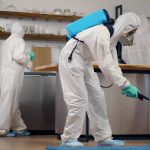Protected lands, such as national parks and nature reserves, are important for preserving biodiversity and ecosystems. However, they can also be vulnerable to pest infestations that can harm the fragile balance of these areas. As a result, safe and eco-friendly pest control methods are crucial for ensuring the protection of these valuable lands.
One of the most significant challenges in pest control for protected lands is finding a balance between preserving the environment and effectively managing pests. Traditional methods of pest control, such as chemical pesticides, can have harmful effects on both human health and the environment. These chemicals can seep into soil and water sources, damaging plant life and endangering wildlife.
Fortunately, there are alternative methods for safe pest control that are being increasingly utilized in protected lands. Integrated Pest Management (IPM) is an approach that focuses on preventing pest problems rather than simply reacting to them after they have occurred. This involves implementing various techniques such as habitat modification, mechanical traps or barriers, biological controls (using natural predators), and finally using chemical pesticides only when necessary as a last resort.
Habitat modification involves making changes to an area’s environment to discourage pests from living there while still supporting other plants or animals. For https://www.cylex-australia.com/company/safe-pest-control-pty-ltd-23903178.html example, removing standing water or areas with potential breeding sites for mosquitos can reduce their population without harming other species in the ecosystem.
Mechanical traps or barriers are another element of IPM that uses physical means to capture pests safely without harming non-targeted species. This method has been particularly successful in controlling invasive species; one example is using specially designed fences around turtle nesting sites to prevent raccoons from preying on eggs.
Another effective way of controlling pests without causing harm is through biological controls or using living organisms such as natural predators or parasites to keep populations in check. For instance, introducing ladybugs into an area infested with aphids will help naturally reduce their numbers without using any chemicals.
However effective these methods might be, it’s essential to recognize that sometimes, chemical pesticides are necessary. In these cases, using environmentally-friendly options is crucial. These include using organic pesticides and baiting techniques which target only the specific pest problem without harming other species.
Another important aspect of safe pest control is regular monitoring and ongoing evaluation of the methods used. This allows for adjustments or changes based on the effectiveness of the current approach and ensures that the control measures do not cause any unintended harm to protected lands.
In conclusion, safe pest control practices for protected lands require a holistic approach that considers both environmental preservation and effective management of pests. It involves preventative measures such as habitat modification, mechanical barriers, and biological controls along with careful use of chemical pesticides when necessary. The ultimate goal is to achieve a balance between protecting biodiversity while effectively managing pests in a sustainable manner. By implementing these methods, we can ensure that our valuable protected lands remain healthy for future generations to appreciate and enjoy.





